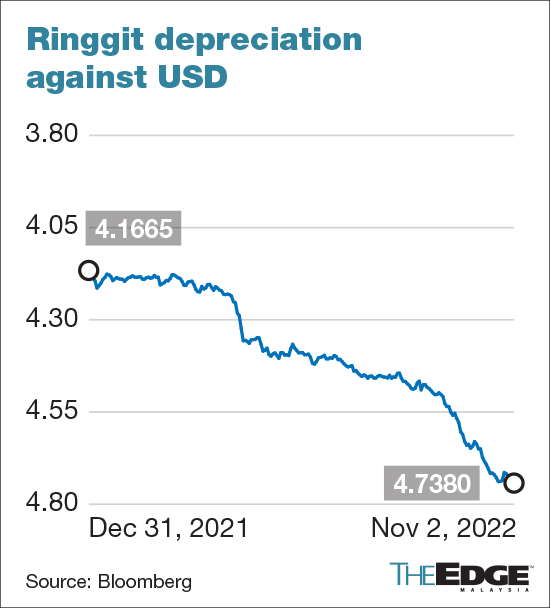
KUALA LUMPUR (Nov 2): The strong US dollar rally resulting from persistent interest rate hikes will continue at least until the first quarter of 2023 (1Q23), before levelling off against other global currencies, said investment officer Todd Jablonski.
This, he said, is in anticipation that the US economy will enter a mild recession in the coming 12 months, which will force the greenback to give up some of its gains made during the US Federal Reserve Board's (Fed's) hawkish interest rate hikes.
The Fed has raised the effective federal funds interest rate from 0.08% in January to 3.08% at the end of September, with another potential hike scheduled on Wednesday (Nov 2).
“The US dollar will be near its peak in 1Q23, and we expect a levelling off, although it will be far from immediate retreat relative to a basket of other currencies. Fed or any monetary policies work on a delay, typically 6-9 months. Sometimes even longer," said Jablonski, the chief investment officer for asset allocation at Principal Asset Management.
“But I think dollar strength will mostly be in the rearview mirror and will continue to see the trajectory move until 1Q23,” said Jablonski at the 2022 Principal APAC Summit organised by Principal Malaysia.
As such, he said the ringgit, along with other Asian currencies would continue to be forced to extend losses until the Fed peaks the estimated interest rate target at a range of of 4.75% to 5% by the end of 2023.
“I will not be surprised to see a single digit decline in the value of the dollar relative to the global basket,” he added.
Jablonski said that due to high volatility in the currency market, investors are better off deploying capital in other assets that promise both yield and stability.
This year has not been in favour of central banks across Asia, as they dipped into their reserves to defend their currency against the strong US dollar. Bank Negara Malaysia’s international reserves have also taken a dip in August and September, as they appear to have been be used to prop up the ringgit.
In the first nine months of 2022, BNM’s international reserve declined from US$116.1 billion to US$106.1 billion. As at Oct 14, the reserves stood at US$104.5 billion.
The drop in international reserves was in tandem with the depreciation of the ringgit, which has shrunk by 13.72% against the US dollar year-to-date. It was trading at 4.738 against greenback on Wednesday.
High commodity prices will extend support to ringgit
But not all is lost for the local unit, said Principal’s chief investment officer for Malaysia, Patrick Chang, noting that Malaysia’s other macroeconomic fundamentals were still relatively better compared to many other emerging economies.
In particular, Malaysia’s position as a strong commodity exporter will extend support to the local unit, he said.
“Obviously, Malaysia being the strong net exporter of oil and gas and crude palm oil, will naturally benefit the ringgit and economy. Having said that, commodities do have its peak, trough and volatility.
“But in the case of Southeast Asian countries like Malaysia and Indonesia, as long as commodity prices stay elevated, then obviously, the current account surplus will continue to grow,” said Chang.
Year-to-date, Brent crude has gained 22% to US$94.64 per barrel, while crude palm oil (CPO) prices rose 13.18% to RM4,398 per tonne, after peaking in April at RM6,270.
Exports of Malaysia’s palm oil and palm-oil based products grew 55.2% between January and June (6M22) to RM67.48 billion, from RM43.47 billion in 6M21, the Plantation Industries and Commodities Ministry said in August.
Another rate hike a fiscally responsible decision
Munirah Khairuddin, Principal’s country head for Malaysia, said BNM’s highly anticipated decision to further tighten the overnight policy rate (OPR) for the fourth time on Thursday (Nov 3), is a fiscally responsible decision to further support the economy, amid an upside risk of inflation and a weaker ringgit.
BNM started the OPR hike in May. It has since raised rates by 75 basis points to keep inflation in check.
“The ringgit vulnerability is not on the back of weak fundamentals but due to the strong US dollar. Interest hike in Malaysia compared to the US is relatively mild. So, we see it as an absolute necessity to hike and stave off any excesses that we have enjoyed for a decade.
“It is really important [that] we beat down inflation. I don’t think BNM is as aggressive as many other global central banks,” said Munirah.
Malaysia’s headline inflation rate, as measured by the consumer price index, eased for the first time in six months to 4.5% year-on-year in September, compared to 4.7% in August. However, core inflation registered an increase of 4% in September, as compared to 3.8% in August, said the Department of Statistics Malaysia on Oct 21.


